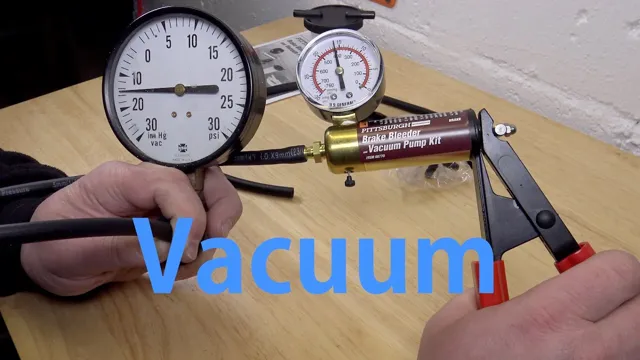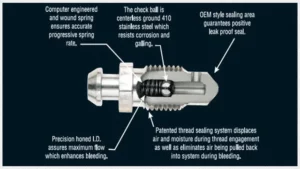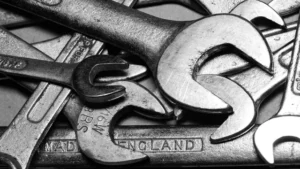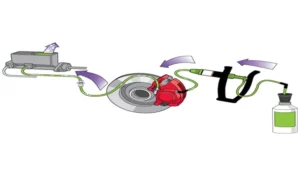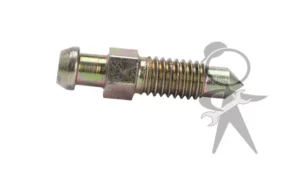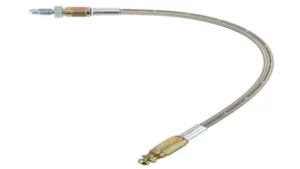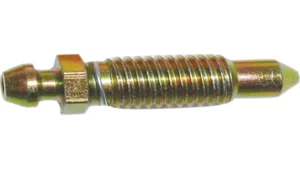Have you ever spent hours trying to bleed your car’s brake system with no success? If so, you’re not alone. Bleeding brakes can be a complicated process, especially if you don’t have the right tools on hand. Fortunately, using a Pittsburgh brake bleeder can make the job a whole lot easier.
A Pittsburgh brake bleeder is a handheld device that allows you to bleed your brakes without needing a second person. Simply attach the bleeder to your brake system and pump the lever until the brake fluid flows smoothly. With this tool, there’s no need to worry about air bubbles or uneven fluid distribution.
But why is bleeding brakes so important? Well, over time, air can get into the brake system, causing spongy or unresponsive brakes. This can be dangerous, particularly when driving at high speeds or in heavy traffic. Bleeding your brakes removes any air in the system, ensuring that your brakes work as they should and keeping you safe on the road.
So, if you’re looking to take on the task of bleeding your brakes yourself, consider investing in a Pittsburgh brake bleeder. With this tool, you’ll be able to complete the process quickly, easily, and with optimal results.
What is the Pittsburgh Brake Bleeder?
If you’re a vehicle owner, you know just how important brake maintenance is. The Pittsburgh Brake Bleeder is a handy tool that can help bleed your brakes in a quick and efficient way. It’s a handheld device that creates a vacuum and suction to remove the air from a brake line.
But how do you use it effectively? Firstly, you need to locate the brake bleeder valve on your vehicle and attach the Pittsburgh Brake Bleeder to it. Then, you’ll need to press the handheld pump to create the vacuum. As you’re pumping, you’ll notice that air bubbles start coming out of the brake line- this is a good sign that the air is leaving the line.
Once you’ve removed all the air, you’ll need to close the bleeder valve and repeat the process on all the other brake lines. The Pittsburgh Brake Bleeder is a great tool for DIY maintenance and can save you time and money in the long run.
Overview of the tool and its components
The Pittsburgh Brake Bleeder is a tool used in automotive repair to bleed brake systems. Its components include a pressure gauge, a reservoir, and a hose to connect to the bleeder valve on the brake caliper. Using the tool simplifies the process of removing air bubbles from the brake lines, ensuring reliable braking performance and improved safety on the road.
The pressure gauge displays the level of pressure being applied to the system, allowing the user to ensure that the correct amount of pressure is being used. The reservoir holds the brake fluid, which is necessary for the bleeding process. With the help of this tool, mechanics and car enthusiasts alike can complete brake bleeding quickly and efficiently, saving money and time.
Improve your brake system’s performance and extend longevity by using the Pittsburgh Brake Bleeder, the go-to tool for brake repair enthusiasts. Keyword: Pittsburgh Brake Bleeder
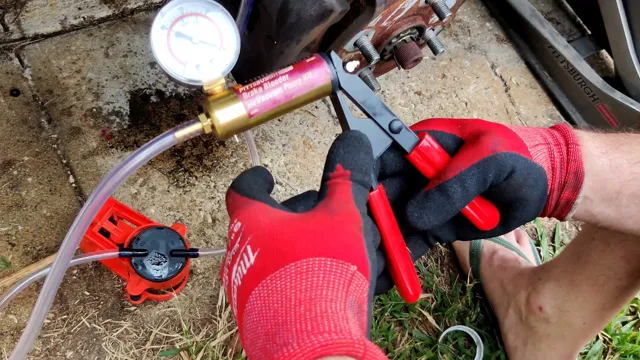
Preparing to Use the Brake Bleeder
Before using a Pittsburgh brake bleeder, it is important to ensure that all necessary tools are available and that the vehicle is in the proper position for brake bleeding. Begin by checking the vehicle owner’s manual to determine the recommended brake bleeding procedure. It is also important to check the oil level and inspect the brake fluid reservoir for any signs of contamination or deterioration.
Once the vehicle is prepared, the next step is to attach the brake bleeder to the vehicle’s brake caliper or wheel cylinder. Make sure that all connections are securely tightened and that the bleeder valve is open. Before starting the brake bleeding process, check to ensure that the brake pedal is not soft or spongy.
If the pedal feels this way, it may be necessary to bleed the master cylinder before proceeding with the brake bleeding process. Once everything is set up, the brake bleeding process can be started, slowly pumping the brake pedal and releasing pressure in the brake lines until the brake fluid runs clear. With proper preparation and attention to detail, the Pittsburgh brake bleeder can be an effective tool for maintaining the brake system of any vehicle.
Gathering supplies and getting your car ready
Before you begin using a brake bleeder, it is important to properly prepare and gather all necessary supplies. Firstly, you will need to acquire a proper brake bleeder kit that includes a bleed valve, a hose, a brake fluid catch container, and a manual hand pump. It is crucial to ensure that the kit is compatible with your car’s braking system.
Additionally, make sure you have enough new brake fluid to refill your car after the bleeding process. Once you have all the necessary supplies, you should also take the time to inspect your car’s brake system for any signs of damage or wear and tear. This includes checking for any leaks or cracked hoses and ensuring that the brake pads and rotors are in good condition.
By taking these precautions, you can help prevent any accidents or damage to your vehicle during the brake bleeding process.
Connecting the Brake Bleeder to Your Car
Are you ready to learn how to use a Pittsburgh brake bleeder on your car? Connecting the brake bleeder to your vehicle is a crucial step in the brake bleeding process. First, you’ll need to locate the brake fluid reservoir and remove the cap. Next, attach one end of the brake bleeder hose to the bleeder valve on your brake caliper and the other end to the brake bleeder bottle.
Make sure the connections are tight to avoid air leaks. Once connected, pump the brake pedal a few times to build up pressure. Then, open the bleeder valve with a wrench and watch as the brake fluid and air bubbles flow into the bottle.
Close the valve and repeat this process on each of your brake calipers until there are no more air bubbles in the brake fluid. Finally, top off the reservoir with fresh brake fluid and replace the cap. With your Pittsburgh brake bleeder and this simple process, you’ll have confidently and efficiently bled your brakes.
Step by step instructions for proper attachment
When it comes to using a brake bleeder on your car, it’s important to properly attach it to ensure a safe and effective brake bleeding process. First, make sure your car is on level ground and the brake fluid reservoir is topped off. Next, find the bleeder screws on your brake calipers and loosen them slightly with a wrench.
Then, attach the brake bleeder to the appropriate screw using the provided adapter and tubing. Once attached, open the valve on the brake bleeder and pump the brake pedal several times to create pressure. Finally, close the valve and repeat the process on each brake caliper until all air bubbles are removed from the brake system.
With these steps, you can confidently use a brake bleeder on your car for efficient maintenance and repairs.
Bleeding the Brakes with the Pittsburgh Brake Bleeder
If you’re looking to bleed your brakes, a Pittsburgh brake bleeder can be a great tool to have on hand. First, make sure your car is safely lifted and the wheels are removed. Next, locate the bleeder valve on your brake caliper and attach the Pittsburgh brake bleeder to it.
Then, pump the bleeder to create pressure and slowly begin opening the bleeder valve. You’ll start to see brake fluid and air bubbles come out; continue to pump the bleeder until you see only fluid and no more air bubbles. Repeat this process for each brake caliper, working from the furthest from the master cylinder to the closest.
Once finished, top off your brake fluid reservoir and take your car for a test drive, ensuring your brakes are working properly. Overall, using a Pittsburgh brake bleeder is a straightforward process that can help ensure the safety and reliability of your vehicle’s braking system.
Instructions for performing brake bleeding with the tool
Bleeding the Brakes with the Pittsburgh Brake Bleeder is a straightforward process, and anyone can do it with the right tools and instructions. Begin by removing the cap from the master cylinder and adding brake fluid until it reaches the “MAX” level. After that, screw the Pittsburgh Brake Bleeder onto the brake fluid reservoir and attach the tubing to the caliper bleed valve.
Next, pump the brake pedal until the bubbles stop appearing in the tubing, indicating the system is free of air. Keep an eye on the brake fluid reservoir and top it up as necessary during the process. Once you’re confident there’s no more air in the caliper, remove the tubing, and close the bleed valve.
Finally, do the same process to the remaining calipers. Ensure you finish the brake bleeding process by testing the brakes to confirm they’re functioning as they should, and don’t forget to check the brake fluid level in the reservoir. Bleeding the brakes is an essential maintenance task that can keep you safe on the road.
So, it is recommended that you perform it every time you diagnose problems with your vehicle’s braking system.
Tips and Tricks for Successful Brake Bleeding
If you’re wondering how to use a Pittsburgh brake bleeder, there are a few tips and tricks you should know. First, make sure you have the right tools for the job, including the brake bleeder kit, brake fluid, and a clean container to catch the old fluid. Before you begin, consult your car’s manual to determine the correct bleeding sequence for your specific make and model.
Then, remove the dust cap from the bleeder valve and attach the bleeder hose. Next, have a helper pump the brake pedal while you open and close the bleeder valve to release the old fluid. As you bleed each wheel, check the brake fluid level and add more as needed.
Finally, test your brakes to ensure they are working properly before taking your car for a spin. By following these tips and tricks, you’ll be able to successfully bleed your brakes using a Pittsburgh brake bleeder.
Common mistakes to avoid and best practices for optimal results
Brake bleeding is an essential maintenance task to ensure your vehicle’s optimal braking performance. Still, many car owners make mistakes that can lead to potential safety hazards. One common error is not using the appropriate brake fluid for your vehicle.
Make sure to check your owner’s manual and use the recommended brake fluid for your car’s make and model. Another common error is not removing all trapped air bubbles in the brake lines, which can lead to a spongy brake pedal and decreased braking effectiveness. To avoid this, you can invest in a brake bleeding kit or have a professional mechanic do it for you.
Before starting the brake bleeding process, ensure that your vehicle is on a level surface and the brake master cylinder is filled to the correct level. Remember, poor brake performance can lead to vehicle accidents, so take your time and follow the proper brake bleeding procedures. By adhering to these best practices, you can experience optimal brake performance, keeping you and your passengers safe on the road.
Conclusion
In conclusion, using a Pittsburgh brake bleeder is as easy as pie (or as some Pittsburghers might say, as easy as eating a Primanti Bros sandwich). Begin by disconnecting your brake bleeder valve and attaching the bleeder hose. Next, open the valve and pump your brake pedal until the old brake fluid is replaced with fresh, new fluid.
Voila! Your brake system is now properly bled and ready for action. So don’t be a yinzer and let your brake fluid go stale – use a Pittsburgh brake bleeder and keep your ride safe and sound. Go Stillers!”
Final thoughts and summary of the benefits of using a Pittsburgh Brake Bleeder
After discussing the benefits of using a Pittsburgh Brake Bleeder, it’s important to cover some tips and tricks for successful brake bleeding. First and foremost, it’s crucial to ensure you have the right tools and equipment before beginning the process. This includes the Pittsburgh Brake Bleeder itself, as well as a container to catch the old brake fluid, fresh brake fluid to replace the old fluid, and an assistant to help pump the brakes.
Next, it’s important to properly prep the brake system before bleeding the brakes. This involves making sure the brake reservoir is full and removing any air bubbles by gently tapping the brake lines. When bleeding the brakes, start with the brake farthest away from the master cylinder and work your way towards the closest brake.
Another helpful tip is to use gravity to your advantage. Rather than solely relying on the pumping of the brakes, allow the brake fluid to flow through the brake lines by opening the bleeder valve and letting gravity do the work. This can be especially helpful for bleeding clutch systems.
Lastly, don’t be afraid to seek out guidance or assistance if needed. Brake bleeding can be a tricky process, and there’s no shame in reaching out to a professional or knowledgeable friend for advice and support. By following these tips and suggestions, you can ensure a successful brake bleeding experience with the Pittsburgh Brake Bleeder.
The benefits of a properly functioning brake system are too important to overlook, so take your time, be patient, and don’t hesitate to ask for help if needed.
FAQs
What is a Pittsburgh brake bleeder and how does it work?
A Pittsburgh brake bleeder is a tool used to remove air from brake lines. It works by creating a vacuum to draw out any air that may be present in the brake system.
How do I use a Pittsburgh brake bleeder?
To use a Pittsburgh brake bleeder, first, attach the bleeder to the brake fluid reservoir. Next, connect the tubing to the bleeder and then attach it to the brake bleeder valve. Then, draw a vacuum using the pump to remove air from the brake lines.
Can I use a Pittsburgh brake bleeder on my own or do I need help?
You can use a Pittsburgh brake bleeder on your own, but it is always recommended to have a second person to assist you.
How often should I bleed my brakes with a Pittsburgh brake bleeder?
It is recommended to bleed your brakes with a Pittsburgh brake bleeder every 2-3 years or whenever you notice a decrease in brake performance.
What are the benefits of using a Pittsburgh brake bleeder?
Using a Pittsburgh brake bleeder ensures that there is no air in the brake lines, which can result in improved brake performance, increased safety, and a longer lifespan for your brake system.
Is it possible to damage my brake system using a Pittsburgh brake bleeder?
It is unlikely to damage your brake system using a Pittsburgh brake bleeder if used correctly. However, it is always important to follow the manufacturer’s instructions carefully and not exceed the recommended pressure limit.
Can I use a Pittsburgh brake bleeder on any type of vehicle?
Yes, Pittsburgh brake bleeders are a versatile tool that can be used on all types of vehicles, including cars, trucks, and motorcycles.
